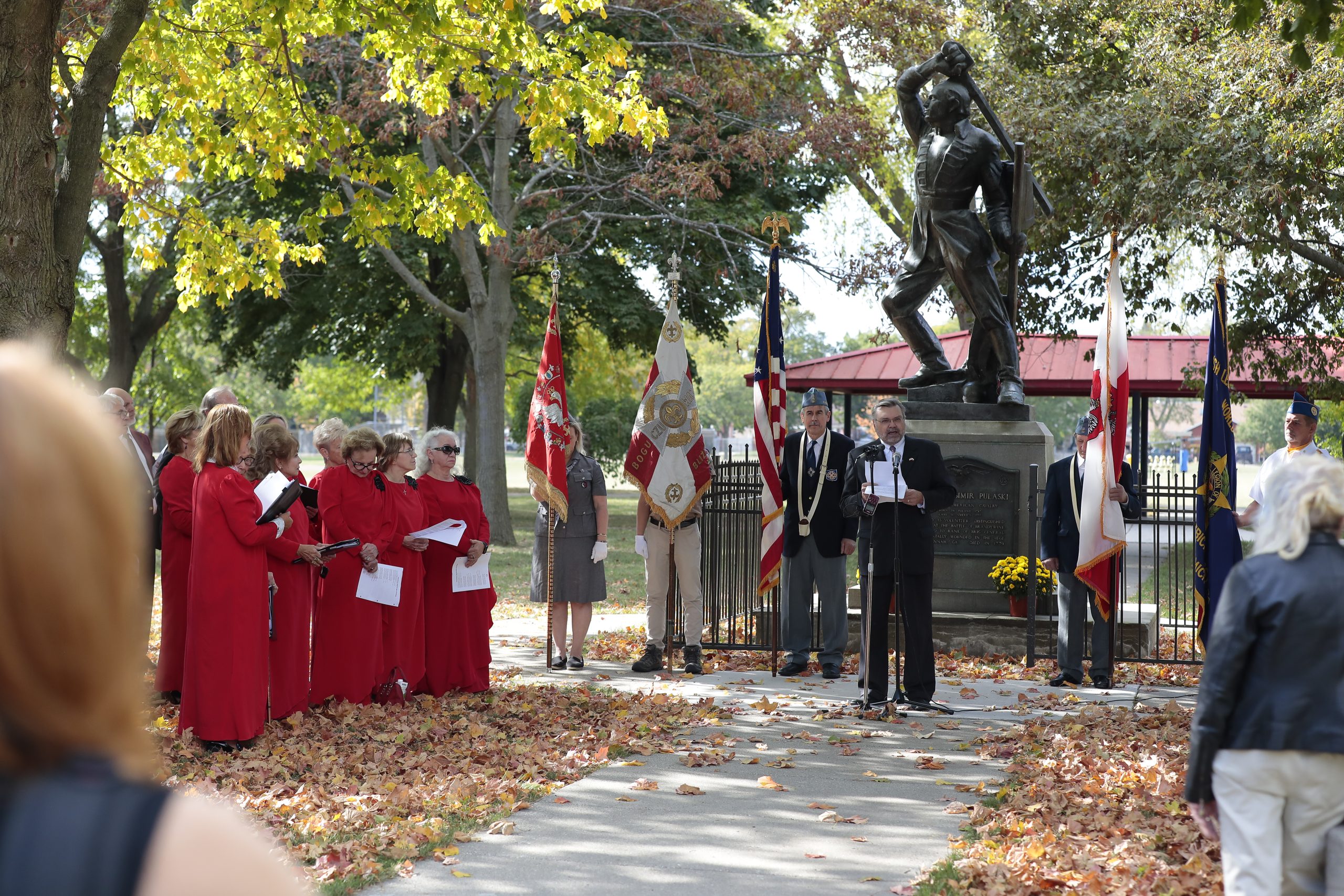Panie Komendancie, drodzy weterani, Wielebny Księże, witam Państwa serdecznie.
Kazimierz Michał Władysław Wiktor Pułaski stał się symbolem walki o wolność dla dwóch narodów – Polski i Stanów Zjednoczonych. Był on polskim szlachcicem, lecz walczył o wolność wszystkich. W Pułaskim górowała miłość kraju i przywiązanie do wolności. Tym ideałom poświęcił swoje życie.
Dla Amerykanów stał się wzorem wspaniałego rycerza z powołania. W 1910ym roku, odsłonięto jego pomnik w Waszyngtonie. Na tej ceremonii Prezydent William Taft powiedział: „Pułaski był rycerzem z krwi i kości. Był synem rycerskiego narodu. Był mężny, odważny i śmiały.”
We all know the story of Casimir Pulaski – a true freedom fighter in Poland and then in America as part of the Continental Army during the American Revolutionary War, which he joined in 1777, when he was just 30 years old. When he arrived in America, he immediately wrote to General Washington offering his services, stating “I came here, where freedom is being defended, to serve it, and to live or die for it.” After he literally saved the life of General Washington, while Washington’s army was in retreat at Brandywine, Pulaski soon became a Brigadier General as was given the command of the American cavalry, known as the Pulaski Legion.
A year later, Washington sent Pulaski and his newly-trained legion to the crucial American base at Charleston, South Carolina, which he valiantly defended. After that, he went on to Savannah, Georgia, where he was min battle.
Almost immediately after his death, Americans considered Pulaski a true hero. When he died, a large public funeral service was held in his honor in Charleston, and the Continental Congress unanimously adopted a resolution to erect a monument in his honor. But, Pulaski’s monument was not erected in Washington DC until 1910, when, a group of Polish Americans from Toledo, Ohio who had discovered the unrealized 1779 resolution, pushed Congress to act. As a result, an impressive statute of Pulaski was finally erected in Washington’s Freedom Plaza. A few years later, in 1929, Congress passed a resolution designating October 11 of each year as “General Pulaski Memorial Day”. In 2009, Congress passed a joint resolution conferring honorary US citizenship on Pulaski, only one of eight people to have such an honor.
Over the years, many streets, highways, counties, towns, schools, courthouses, squares, buildings, parks and bridges throughout the United States, especially in the South, have been named in honor of Pulaski. Appropriately, on November 30, 1937, acting at the request of the Wyandotte Council of Clubs, the Wyandotte City Council adopted a resolution officially naming this park Pulaski Park, “in honor of the American Revolutionary War hero, Brigadier General Casimir Pulaski.”
So how did this prominent statute of Pulaski get here? It’s an interesting story. The statue was the work of a renowned Polish sculptor – Ksawery Dunikowski. Dunikowski was born in Kraków, and became a notable sculptor and professor at the Academy of Fine Arts in Warsaw, a professorship he would hold until 1909 when he was appointed the Chair of Sculpture Department at the Jan Matejko Academy of Fine Arts in Kraków.
This statute of Pulaski wasn’t Dunikowski’s only sculpture having ties to the United States. After WWI, when Poland regained its independence, the Polish government commissioned him to sculpt a statute to thank the United States for sending tens of millions of dollars’ worth of food to the newly reconstituted, war-torn Poland, to nourish young Polish children during times of severe food shortages. In 1922, at a rally attended by Polish and American dignitaries and diplomatic corps and thousands of Polish schoolchildren, his sculpture, called the “Monument of the Gratitude for America”, was unveiled.
Some 15 years later, as Poland was getting ready for the 1939 World’s Fair to take place in New York, Poland commissioned Dunikowski to sculpt something appropriate. And this is what Dunikowski sculpted – this statue of General Pulaski. It was displayed in the Polish Pavilion at the NY World’s Fair. An entirely appropriate theme, showing the strong bond between Poland and the United States.
But as the World Fair was still open, Germany invaded Poland, starting WWII. This statue, like other artwork at the Polish Pavilion, was not sent back to Poland, but remained in the US. Eventually, Dunikowski’s statue of Pulaski was given to the City of Wyandotte, and placed here, in Pulaski Park. The statue was originally cast in concrete and it started to deteriorate in the elements. So, in 1991, it was re-cast in bronze.
Just one more note about the sculptor Dunikowski. During WWII, in May of 1940, the Germans arrested and deported him to Auschwitz. He was imprisoned there until the death camp was liberated in 1945 and he narrowly evaded execution at least two times for insubordination, thanks to the efforts of some fellow Polish prisoners who somehow arranged to have him transferred to an infirmary within the camp due to severe illness. After the war, he returned to his position at the Academy of Fine Arts in Kraków, and resumed sculpting.
I’m telling you the story of this statute, of its sculptor, and of this park for a couple reasons. First, what we have before us here, in Pulaski Park, is not only a notable sculpture by a renowned Polish artist, but a commemoration of Casimir Pulaski of historical significance. This story tells of the deep historical connection between the Polish people with the American story, symbolized by this monument to Pulaski.
The second reason I’m telling you this is because I think that this statue, and its place in Wyandotte’s Pulaski Park, deserves to be formally and officially enshrined in the U.S. National Register of Historic Places. Of the many monuments of Pulaski, only a handful are registered in the National Register: one in Washington, DC, one in Savannah, and one in Chicago.
To get this site registered in the National Register involves a process. We would need first to send an application with background materials to Michigan’s State Historic Preservation Office. Once the state office approves the application, it is sent to the National Register for consideration. This usually takes several months, but it is well worth the effort. So, if we could get some Polish organizations to participate, and with the blessing of the City of Wyandotte and maybe its historical commission, I would be happy to help coordinate in putting together the application materials.
The story of Pulaski Park and of this statue is inspiring and needs to be enshrined in the annals of American history. What better way to do that than to get an official recognition in the National Registry.
I would like to thank the City of Wyandotte for hosting the statue of General Pulaski in Pulaski Park, and to thank the Polish Army Veterans Post 95 for upholding this important annual tradition of commemorating a great freedom fighter and General of the American Continental Army – General Casimir Pulaski.









